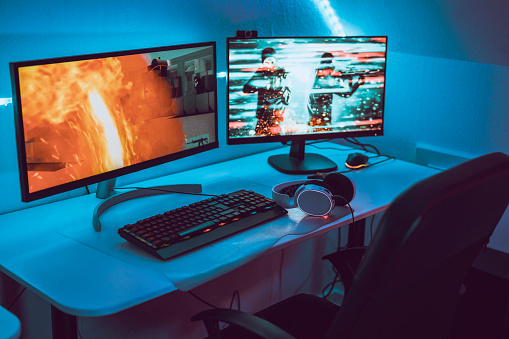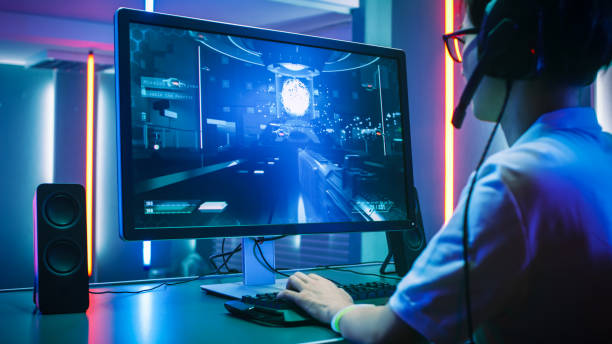There are many factors to consider when it comes to what size monitor for gaming you should opt for. In this article, we will discuss the different aspects you need to take into account when making your purchase.
Finally, we will conclude with a few frequently asked questions about gaming monitors.
1. How to determine the size of monitor you need for gaming
As a starting point, you’ll want to think about the resolution and pixel density of your monitor. This is how many pixels the image on your screen has. A higher resolution means that there are more pixels, making for a sharper image.
There are different resolutions available, but the most common ones you’ll see are 1080p and 1440p.
The next thing you’ll want to consider is the size of your monitor. This is measured in inches diagonally from corner to corner. Larger monitor sizes will give you a bigger screen to play on, but it also means that your games will appear smaller.
Once you’ve decided on the monitor’s screen resolution, next comes the refresh rate of the computer monitor. The refresh rate is how often your screen’s picture is refreshed, and it’s measured in hertz (Hz). A higher refresh rate implies that the image will be updated more frequently, resulting in a smoother gaming experience.
Finally, you’ll want to consider the input lag. This is the amount of time it takes for your monitor to process what’s happening on your screen. A lower input lag means that your games will respond more quickly to what you’re doing.
What Size Monitor For Gaming Should You Opt For?
So, what size monitor should you opt for? It really depends on what you’re looking for in a gaming experience. If you want the sharpest image possible, go for a 1440p monitor. If you’re looking for a smooth gaming experience, go for a monitor with a high refresh rate. And if you want your games to respond quickly to what you’re doing, go for a monitor with a low input lag.
2. What resolution to look for when purchasing a gaming monitor
When choosing what resolution to look for when purchasing your gaming monitor, there are a few things you need to take into account. The first is what graphics card you have. Most graphics cards these days can handle resolutions up to and including 1080p, which is full HD. If you have a higher-end graphics card though, such as one of NVIDIA’s new RTX 20-series cards, then you’ll be able to take advantage of resolutions even higher than 1080p.
The next thing you need to consider is how large of a monitor you want. If you’re looking for a monitor that’s 27 inches or larger, then chances are you’re going to want to go with a resolution of 1440p or higher.
3. What type of panel technology is best for gaming monitors
When buying a gaming monitor, it is easy to be overwhelmed by the panel variety available. Let’s have a look at the advantages and disadvantages of each.
You’re in the market for a new gaming monitor and have already decided on the main features. Screen size, resolution, and, of course, price range are all factors to consider.
But just as you’re about to click “purchase,” you realize that monitors come in a variety of panel kinds, and that differing production procedure are believed to make a major difference. What exactly do you require? IPS, TN, or VA?
Each production method is tailored to specific gaming habits and, in some cases, genres. If you have a particular interest in a particular form of game or simply want to enjoy them all, then choosing one type of panel over another could be quite beneficial.
4. Factors to consider when choosing a refresh rate for your gaming monitor
If you’re a competitive gamer, every millisecond counts. That’s why many gamers opt for a gaming monitor with a high refresh rate. A higher refresh rate means that your monitor can display more frames per second, which can give you a competitive advantage, especially when enjoying fast paced gaming.
However, there are other factors to consider when choosing a refresh rate for your gaming monitor. One is the response time. A lower response time means that your monitor can display each frame more quickly, which can reduce ghosting and blurring.
Another factor to consider is the resolution. A higher resolution will give you a sharper image, but it will also require more processing power from your computer. So if you have an older computer, you may want to stick with a lower resolution. But in the case of a pc system that is computationally optimized, a higher resolution would be the best choice.
Finally, you’ll also want to consider the size of your monitor. A larger monitor will give you a wider field of view, but it will also be more expensive. So if you’re on a budget, you may want to stick with a smaller monitor.
So what size monitor should you opt for? It really depends on your budget and your needs. But if you’re a competitive gamer, you’ll want to look for a gaming monitor with a high refresh rate and a low response time.
5. Which ports are available on a gaming monitor?
The ports available on a gaming monitor are DisplayPort, HDMI, DVI and VGA. DisplayPort is the most common port found on gaming monitors. It is used to connect the monitor to the computer.
HDMI is used to connect the monitor to a TV or other display device. DVI is used to connect the monitor to a computer. VGA is used to connect the monitor to a TV or other display device.
6. How much should you spend on a gaming monitor
The answer to this question depends on a few factors. First, what kind of games do you play? If you’re a competitive FPS player, then you’ll want a monitor that can display fast action without any blurring.
This means opting for a higher refresh rate and possibly even a lower resolution. On the other hand, if you’re mostly playing single-player RPGs, then you might be more interested in a large monitor with a high resolution.
Second, what’s your budget? If you have the money to spend, then you can get a great gaming monitor without breaking the bank. However, if you’re on a tight budget, then you’ll need to make some compromises.
Third, what other hardware are you using? If you have a powerful graphics card, then you’ll be able to take advantage of higher resolutions and frame rates. Conversely, if you’re using an older or less powerful card, then you might need to stick with lower settings.
Ultimately, the answer to this question is up to you. Consider what you need and what you can afford, and make your decision accordingly.
Conclusion | Size Monitor For Gaming
The answer will depend on a number of factors, including the resolution of your graphics card, the size of your room, and how far away from the screen you like to sit.
Generally speaking, larger monitors are better for gaming. They give you more screen real estate to work with, which can be helpful in some games. And they can also be more immersive, making you feel like you’re really in the game.
Of course, there are downsides to large monitors as well. They can be more expensive, and they take up more space. If you have a small room, or if you like to sit close to your screen, a smaller monitor might be a better option.
Ultimately, the best size for your gaming monitor is the one that works best for you. Consider all of the factors mentioned above, and then make a decision based on what will work best for your needs.
FAQs | What Size Monitor For Gaming Should You Opt For?
Q: What is the ideal monitor size for gaming?
A: While there is no definitive answer, most gamers opt for a monitor size between 24 and 27 inches.
Q: Does the monitor size affect performance?
A: Generally speaking, no. However, some gamers believe that larger monitors provide a more immersive gaming experience. But in reality, most ultrawide monitors contribute to a better viewing experience but have no impact on the gaming performance.
Q: What other factors should I consider when choosing a gaming monitor?
A: In addition to size, you’ll also want to consider things like resolution, refresh rate, peripheral vision, etc. We go over all of these topics in our ultimate guide to choosing the best gaming monitor.



